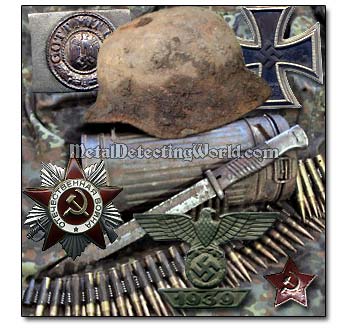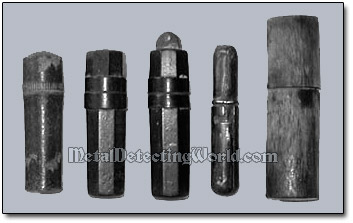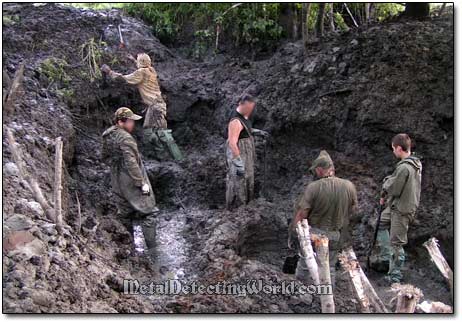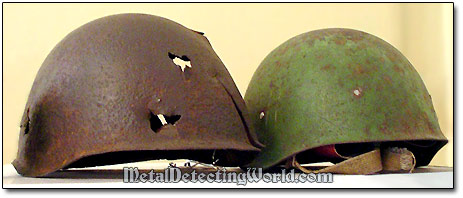Types of Metal Detecting Activities, page 6:
WW2 MILITARY RELIC HUNTING:
General Information, Tips, Metal Detectors and Accessories Required

WW2 Military Relic Hunting is about metal detecting all kinds of World War II artifacts - soldiers' personal items, field gear items, trench art items, soldiers' ID tags, uniform accessories and insignia, war decorations, weapons (machinery, firearms and cold steel) and their parts, unexploded ordnance (UXO), etc. World War II relic hunting is similar to searching for World War I military artifacts.
Non-metallic WW2 relic finds such as, for example, Red Army soldier ID medallions made of black textolite are also highly sought by military relic hunters.
Such medallions are extremely valuable because they are the only means to ID the remains of soldiers who have been MIA's until now. A special technique is used to open each medallion and extract a small piece of paper - a soldier's ID form.
Unfortunately even these medallions fail to help because most of the soldiers' ID forms usually are not filled out due to a common superstitious belief - "if you fill it out, you will get killed!"
WW2 Red Army Soldier ID Medallions Made of Black Textolite

As World War II Military Relic Hunting has become very popular in Europe, there are many official and non-official civilian groups and organizations actively participating in the process. They mainly focus on recovery and ceremonial reburial of soldiers' remains, identification of unknown soldiers killed in action (KIA), and notification of their relatives if they are still alive.
For instance, even a special WW2 relic hunting battalion has been recently formed in the Russian Army to carry out these tasks.
And of course, there are thousands of individuals who explore and search countless WW2 sites - numerous battlefields, endless trench lines, dug-outs, fox holes, pillboxes, underground bunkers and caches of weapons that have survived the time. Military relic hunters dig huge holes, sometimes excavating endless cubic yards of dirt, to get to the bottom of large dug-outs.
A Group of Military Diggers Excavating the WW2 Dug-Out

These military diggers are not always lucky and have to put themselves trough titanic labor for recovering sometimes nothing but a couple of rusty and holed steel helmets.
Two Excavated WW2 Steel Helmets

Some WW2 relic hunters are so addicted to recovering WW2 artifacts that they hunt all year around, even during freezing months of the winter. Besides metal detectors, their equipment includes especially designed steel probes, electric generators, water pumps, super powerful magnets that can hold iron pieces up to 300kg of weight, and various digging tools such as shovels, pickaxes, sleigh hammers and crowbars.